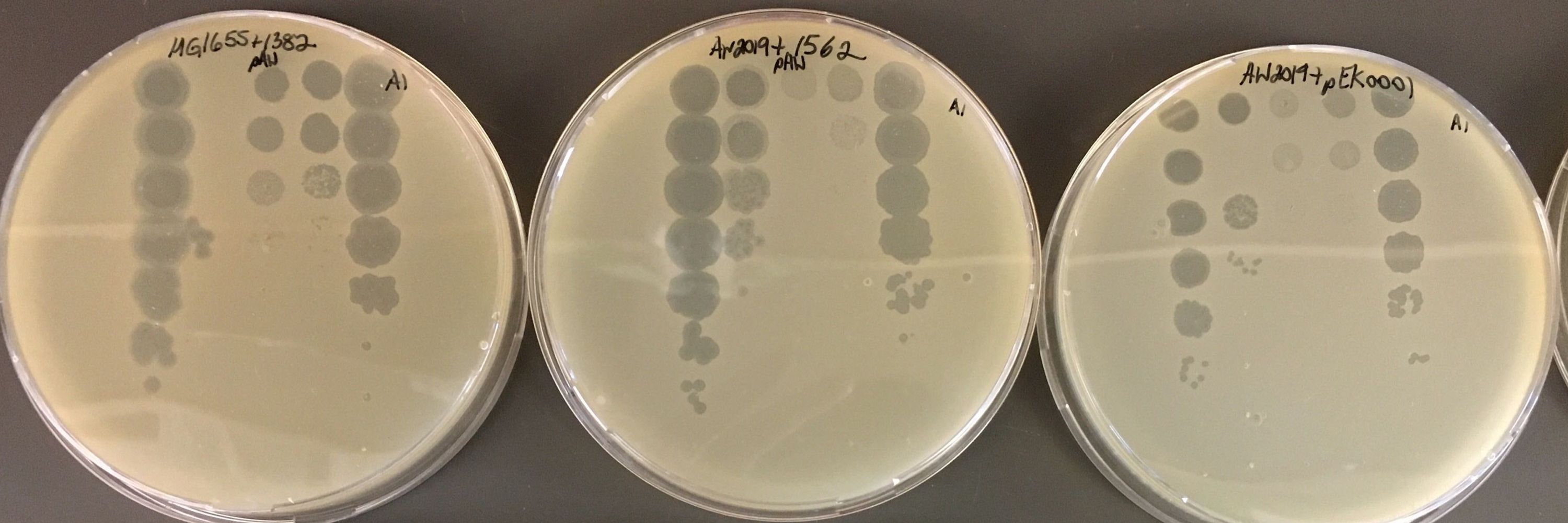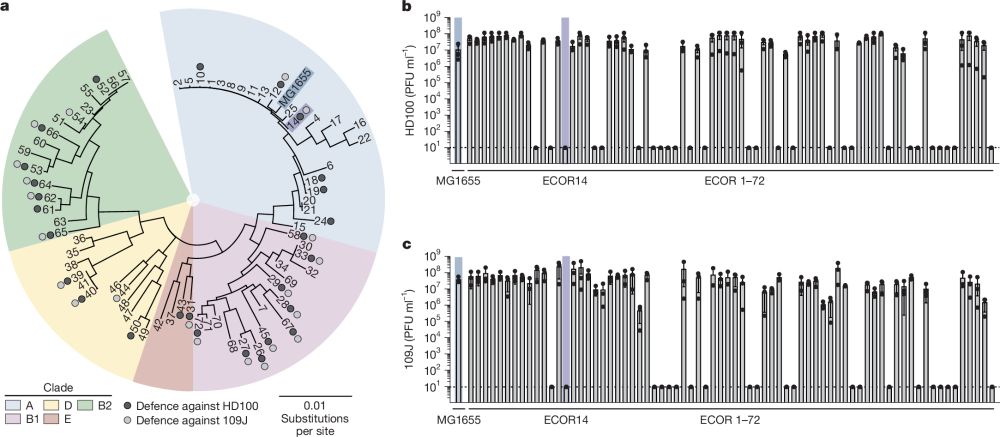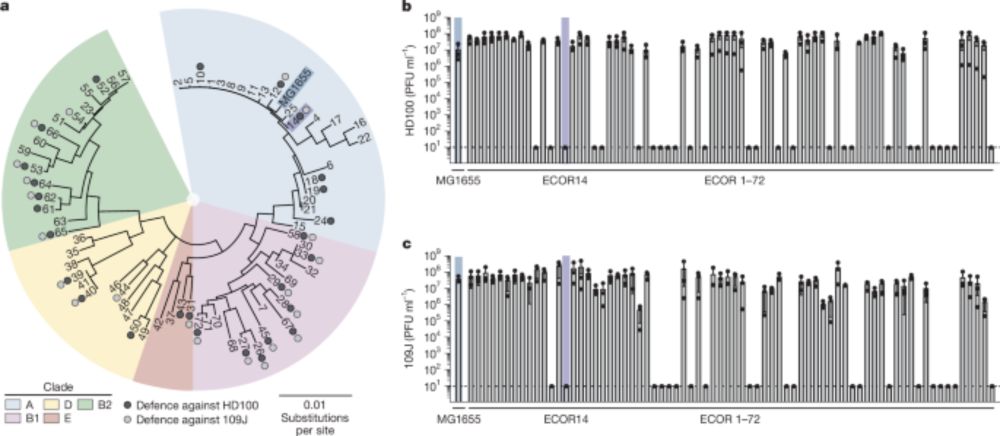
Aaron Whiteley
@aaronwhiteley.bsky.social
Assistant Professor at the University of Colorado Boulder. Microbiologist. All-around nerd.
http://colorado.edu/lab/aaron-whiteley/
http://colorado.edu/lab/aaron-whiteley/
@mfwhite2.bsky.social reviewed both papers in a News and Views and put the collaboration between phage defense systems best: "scientists can confidently conclude that bacterial defences are indeed more than just the sum of their parts" www.nature.com/articles/d41...

Bacteria use a decoy defence molecule to set a trap for viruses
Some bacterial-infecting viruses use ‘sponges’ to mop up defence molecules, but bacteria can fight back by responding when a sponge captures decoy molecules.
www.nature.com
October 8, 2025 at 11:14 AM
@mfwhite2.bsky.social reviewed both papers in a News and Views and put the collaboration between phage defense systems best: "scientists can confidently conclude that bacterial defences are indeed more than just the sum of their parts" www.nature.com/articles/d41...
Check out the complementary story from @doudna-lab.bsky.social led by @erinedoherty.bsky.social and @benadler.bsky.social Their work on OptE oligomerization is particularly crucial to completing our understanding of Panoptes. www.nature.com/articles/s41...

A miniature CRISPR–Cas10 enzyme confers immunity by inhibitory signalling - Nature
Panoptes, an anti-phage defence system against virus-mediated immune suppression, is revealed.
www.nature.com
October 8, 2025 at 11:14 AM
Check out the complementary story from @doudna-lab.bsky.social led by @erinedoherty.bsky.social and @benadler.bsky.social Their work on OptE oligomerization is particularly crucial to completing our understanding of Panoptes. www.nature.com/articles/s41...
This work was led by @aesully98.bsky.social and was a fantastic collaboration with @benmorehouse.bsky.social + lab. Thanks to all authors including Aravind and Max Burroughs at NIH
October 8, 2025 at 11:14 AM
This work was led by @aesully98.bsky.social and was a fantastic collaboration with @benmorehouse.bsky.social + lab. Thanks to all authors including Aravind and Max Burroughs at NIH
Panoptes guards the CBASS pathway (bacterial cGAS-STING). One facet of this work that I find particularly exciting is the genetic linkage between Panoptes and CBASS, which significantly co-occur in bacterial genomes. What other phage defense systems may be genetically (and functionally) linked?
October 8, 2025 at 11:14 AM
Panoptes guards the CBASS pathway (bacterial cGAS-STING). One facet of this work that I find particularly exciting is the genetic linkage between Panoptes and CBASS, which significantly co-occur in bacterial genomes. What other phage defense systems may be genetically (and functionally) linked?
Nucleotide second messengers are frequently antagonized by viruses. However, Panoptes turns this weakness into an opportunity. www.nature.com/articles/s41...

The Panoptes system uses decoy cyclic nucleotides to defend against phage - Nature
The Panoptes antiphage system defends bacteria by detecting phage-encoded counter-defences that sequester cyclic nucleotide signals, triggering membrane disruption and highlighting a broader strategy of sensing immune evasion through second-messenger surveillance.
www.nature.com
October 8, 2025 at 11:14 AM
Nucleotide second messengers are frequently antagonized by viruses. However, Panoptes turns this weakness into an opportunity. www.nature.com/articles/s41...
Two important conceptual advances I want to highlight: using a large library of plasmids expressing 100’s of phage proteins allowed us to (1) identify new phage defense systems independent of genome context and (2) characterize known defense systems that did not yield phage escaper mutants
July 12, 2025 at 1:53 PM
Two important conceptual advances I want to highlight: using a large library of plasmids expressing 100’s of phage proteins allowed us to (1) identify new phage defense systems independent of genome context and (2) characterize known defense systems that did not yield phage escaper mutants
A publicly available link for the paper can also be found here: rdcu.be/euu5Y

Functional amyloid proteins confer defence against predatory bacteria
Nature - Escherichia coli uses curli fibres, oligomers of the functional amyloid CsgA, as a barrier to protect against the predatory bacteria Bdellovibrio bacteriovorus and Myxococcus xanthus in a...
rdcu.be
July 3, 2025 at 11:18 AM
A publicly available link for the paper can also be found here: rdcu.be/euu5Y
We are just at the beginning of understanding defense against predatory bacteria and the many roles of amyloid proteins across bacteria. Stay tuned for more great work from the Ledvina lab, starting this year at the University of Michigan!
Extremely excited to share I have accepted an offer to be an Assistant Professor in the MCDB department at the University of Michigan! Go Blue! The Ledvina lab will investigate the molecular interworking of the bacterial immune systems including defense against both viral and bacterial pathogens.

July 3, 2025 at 11:18 AM
We are just at the beginning of understanding defense against predatory bacteria and the many roles of amyloid proteins across bacteria. Stay tuned for more great work from the Ledvina lab, starting this year at the University of Michigan!
Great science can only happen with great people. Hannah and all coauthors (including 3 undergraduates!) made this work possible. In particular, our collaboration with Aravind and Max Burroughs at the NIH helped expand this analysis to identify the expanse of bacterial amyloid proteins.
July 3, 2025 at 11:18 AM
Great science can only happen with great people. Hannah and all coauthors (including 3 undergraduates!) made this work possible. In particular, our collaboration with Aravind and Max Burroughs at the NIH helped expand this analysis to identify the expanse of bacterial amyloid proteins.
Here, we find that defense against predatory bacteria is very different from most modes of defense against phage. Bacteria build a "molecular suit of armor" using functional amyloid proteins to protect themselves. A new role for a fascinating set of proteins. www.nature.com/articles/s41...

Functional amyloid proteins confer defence against predatory bacteria - Nature
Escherichia coli uses curli fibres, oligomers of the functional amyloid CsgA, as a barrier to protect against the predatory bacteria Bdellovibrio bacteriovorus and Myxococcus xanthus in a mechanism th...
www.nature.com
July 3, 2025 at 11:18 AM
Here, we find that defense against predatory bacteria is very different from most modes of defense against phage. Bacteria build a "molecular suit of armor" using functional amyloid proteins to protect themselves. A new role for a fascinating set of proteins. www.nature.com/articles/s41...

